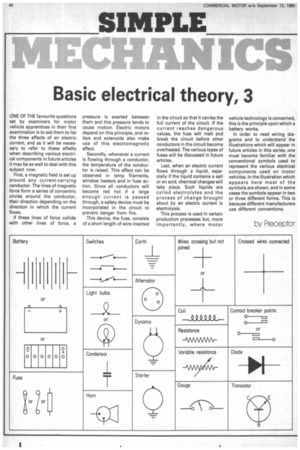Basic electrical theory, 3
Page 42

If you've noticed an error in this article please click here to report it so we can fix it.
ONE OF THE favourite questions set by examiners for motor vehicle apprentices in their first examination is to ask them to list the three effects of an electric current, and as it will be necessary to refer to these effedts when describing various electrical components in future articles it may be as well to deal with this subject now.
First, a magnetic field is set up around any current-carrying conductor. The lines of magnetic force form a series of concentric circles around the conductor, their direction depending on the direction in which the current flows.
If these lines of force collide with other lines of force, a pressure is exerted between them and this pressure tends to cause motion. Electric motors depend on this principle, and relays and solenoids also make use of this electromagnetic effect.
Secondly, whenever a current is flowing through a conductor, the temperature of the conductor is raised. This effect can be observed in lamp filaments, window heaters and in fuse action. Since all conductors will become red hot if a large enough current is passed through, a safety device must be incorporated in the circuit to prevent danger from fire.
This device, the fuse, consists of a short length of wire inserted in the circuit so that it carries the full current of the circuit. If the current reaches dangerous values, the fuse will melt and break the circuit before other conductors in the circuit become overheated. The various types of fuses will be discussed in future articles.
Last, when an electric current flows through a liquid, especially if the liquid contains a salt or an acid, chemical changes will take place. Such liquids are called electrolytes and the process of change brought about by an electric current is electrolysis.
This process is used in certain production processes but, more importantly, where motor vehicle technology is concerned, this is the principle upon which a battery works.
In order to read wiring diagrams and to understand the illustrations which will appear in future articles in this series, one must become familiar with the conventional symbols used to represent the various electrical components used on motor vehicles. In the illustration which appears here most of the symbols are shown, and in some cases the symbols appear in two or three different forms. This is because different manufacturers use different conventions.












































































































